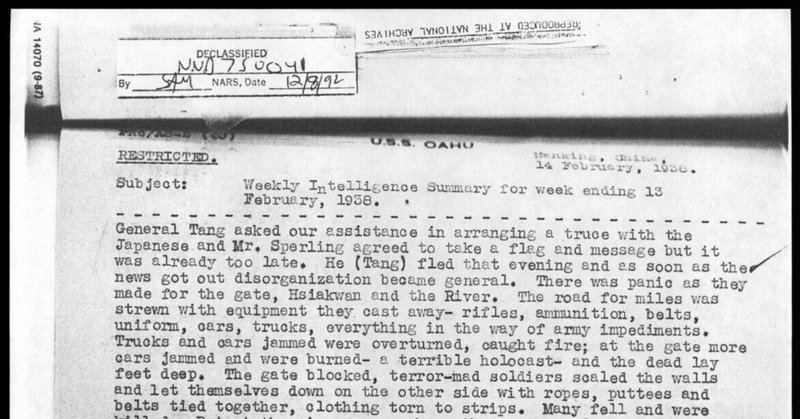
南京戦前後に中国軍が自滅したと言う米軍の記録
1937年12月の南京戦では激しい戦闘が行われましたが、実はそれだけではなく、中国軍が自滅したと言う内容の公文書が残っています。
それがこれ。

✅ 出典情報
ASIATIC FLEET. WEEKLY INTELLIGENCE SUMMARIES. 1938, JANUARY-APRIL
LOU-ASIATIC-127~096 (USC DC Image)
ぎよみどんさんの話では、これは南京攻略戦前後、揚子江上にいた米軍USSオアフ号による公文書らしいです。

📔 公文書英文抽出&和訳
General Tang asked our assistance in arranging a truce with the Japanese and Mr. Sperling agreed to take a flag and message but it was already too late.
He (Tang) fled that evening and as soon as the news got out disorganization became general.
There was panic as they made for the gate, Hsiakwan and the River.
The road for miles was strewn with equipment they cast away- rifles, ammunition, belts, uniform, cars, trucks, everything in the way of army impediments.
唐将軍は日本軍との停戦を取り決めるために私たちに協力を求め、スパーリング氏は旗と伝言を持っていくことに同意したが、時すでに遅しだった。
その夜、彼(唐)は逃げ出し、その知らせが伝わるや否や、組織は総崩れとなった。
彼らは城門、下関(区)、河(揚子江)向かってパニックになった。
何マイルも続く道には、ライフル、弾薬、ベルト、軍服、車、トラック、軍隊の障害となるもの全ての装備品が投げ捨てられていた。
Trucks and cars jammed were overturned, caught fire; at the gate more cars jammed and were burned - terrible holocaust - and the dead lay feet deep.
The gate blocked, terror-mad soldiers scaled the walls and let themselves down on the other side with ropes, puttees and belts tied together, clothing torn to strips.
Many fell and were killed.
渋滞したトラックと車は横転炎上; ゲートではさらに車が渋滞し燃やされ、恐ろしいホロコーストとなり、死者は足の先まで埋まっていた。
門をふさがれ、恐怖に駆られた兵士たちが壁をよじ登り、ロープ、パット、ベルトを結びつけ、服を引き裂きながら反対側に身を降ろした。
多数が落下死した。
But at the river was perhaps the most appalling scene of all.
A fleet of junks was there.
It was totally inadequate for the horde that was now in a frenzy to cross to the north side.
The over crowded junks capsized; they sank; thousands drowned.
Other thousands tried to make rafts of the lumber on the river front, only to suffer the same fate.
Other thousands must have succeeded in getting away, but many of those were probably bombed by Japanese planes a day or two later.
しかし、川では、おそらく最も悲惨な光景が広がっていた。
そこにはジャンク船の船団がいた。
それは北側へ渡ろうと躍起になっている大群には全く歯が立たなかった。
混雑した船は転覆;沈没し数千人が溺死した。
他の何千人もの人々は川岸にて材木でいかだを作ろうとしたが、同じ運命をたどった。
また何千人もの人々が逃げ出すことには成功したはずだが、その多くは1日か2日後に日本軍の戦闘機により爆撃されたのだろう。
One small detail of three companies rallied under their officers, crossed the Sanchiaho, three miles up the river, and tried to attack the Japanese forces coming from that direction but were outnumbered and practically decimated.
Only one seems to have succeeded in getting back.
He happened to be the brother of a friend of mine and appeared in my office the next morning to report the story.
A fellow officer had drowned while the two of them were trying to swim the small tributary to the Yangtze which they had crossed before on rafts, and before daylight he had managed to scale the walls and slip in unobserved.
3個中隊の小さな部隊が将校のもとに結集し、3マイル上流の Sanchiaho を渡り、その方向から来る日本軍を攻撃しようとしたが、多勢に無勢で実質的には壊滅状態であった。
一人だけが帰還に成功したようである。
彼はたまたま私の友人の弟で、翌朝私のオフィスに現れ、その話を報告した。
以前はいかだで渡っていた揚子江の小さな支流を二人が泳ごうとしている間に同僚の警官が溺死、そして夜が明ける前に彼は何とか壁を乗り越え、人知れず潜り込んだ。
So ended the happy, peaceful, well ordered, progressive regime which we had been enjoying here in Nanking and on which we had built our hopes for still better days.
For the Japanese were already in the city and with them came terror, destruction and death.
They were first reported in the Zone at eleven o'clock that morning, just a small detachment at the Southern entrance to the Zone.
こうして、私たちがここ南京で享受し、より良い日々への希望を築いてきた、幸福で平和で秩序ある進歩的な体制は終わりを告げた。
日本軍はすでに南京に上陸しており、恐怖と破壊と死をもたらしていた。
日本軍の上陸が最初に報告されたのは、その日の午前11時、南京の入り口にいた小さな分隊だった。
That was the 13th. They showed no hostility, though a few moments later they killed twenty refugees who were frightened by their presence and ran from them.
For it seems to be the rule here as it was in Shanghai in 1938 that anyone who ran must be shot or bayoneted.
Meanwhile we were busy at headquarters disarming soldiers who had been unable to escapes and had come into the Zone for protection.
We assured them that if they gave up their equipment their lives would.
それは13日であった。
彼らは敵意を示さなかったが、しばらくして彼らの存在に怯えて逃げ出した20人の難民を殺害した。
1938年の上海と同様、ここでも逃げる者は射殺するか銃剣で突くのが決まりのようだ。
一方、私たちは本部で逃げ遅れて保護を求めてゾーンに入ってきた兵士たちの武装解除に追われた。
私たちは、もし彼らが装備を放棄すれば命は保証されると断言した。
日本軍がいよいよ南京に迫る
⏬
司令官の唐将軍が怖くなって南京から逃げ出す
⏬
中国兵がパニックを起こす
日本軍に捕まらないように武器を投げ捨て民間人の服を着て変装
⏬
中国兵は我先に逃げ出そうとする
⏬
⏬
⏬
🚨 阿鼻叫喚の地獄絵図が発生🚨
✅ 激しい渋滞と大火災で丸焼け 🔥
✅ 南京城の壁から外に出ようとうして落下死 👻
✅ 筏などで揚子江から脱出しようとして溺死 🚤
この公文書には書かれていませんが、『挹江門』の辺りで発生した中国軍の督戦隊による自軍兵の殺害事件を『挹江門事件』と言います。
でも、英語ではこれに当てはまる単語がなく、挹江門と言う英単語を見つけるのすら苦労しました。😑
これらの大惨事のせいで、下関や挹江門の辺りは遺体だらけになってしまいました。

2週間遅れで南京入りした村瀬守保氏が『下関埠頭』で大量の遺体を見て、これは日本軍の大虐殺に違いないと謎の確信をしたようですが、実際にはそれは大半が『中国軍の自滅死』だったわけです。
ちなみに、バリバリの共産党員で共産党から出馬まで行った村瀬守保氏は、実際の南京の虐殺現場は目にしていません。
遺体を見て日本軍による虐殺だと決めつけて著書に書いただけです。
そして、村瀬守保氏のその著書は南京大虐殺の証拠として日本人叩きの材料として使われ続けています。
📓 南京大虐殺・731部隊・上海事変の捏造情報
この記事が気に入ったらサポートをしてみませんか?
